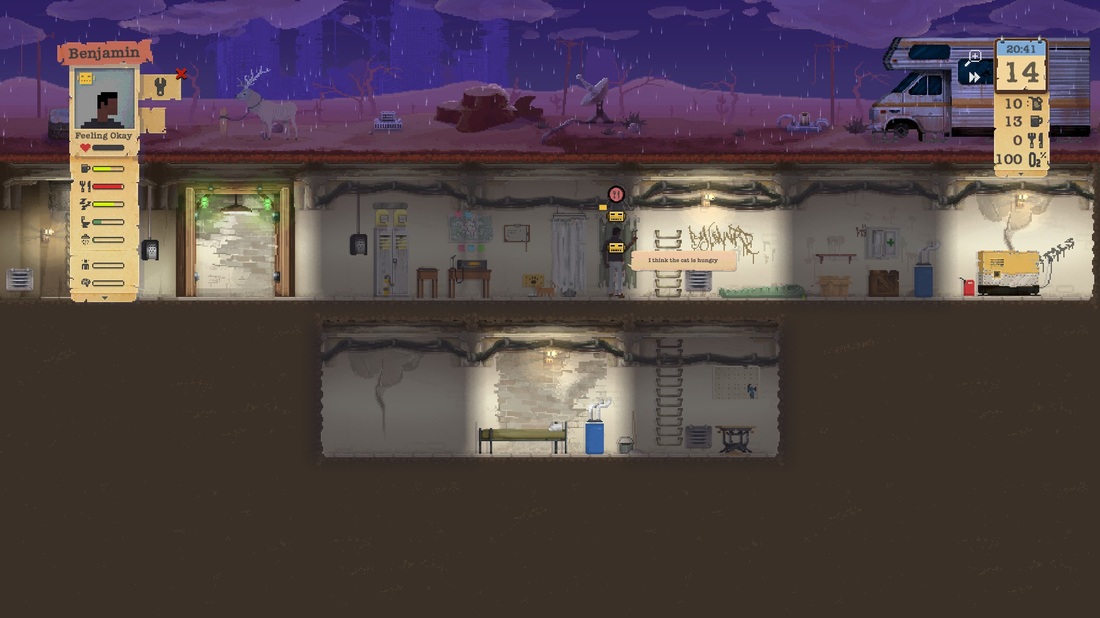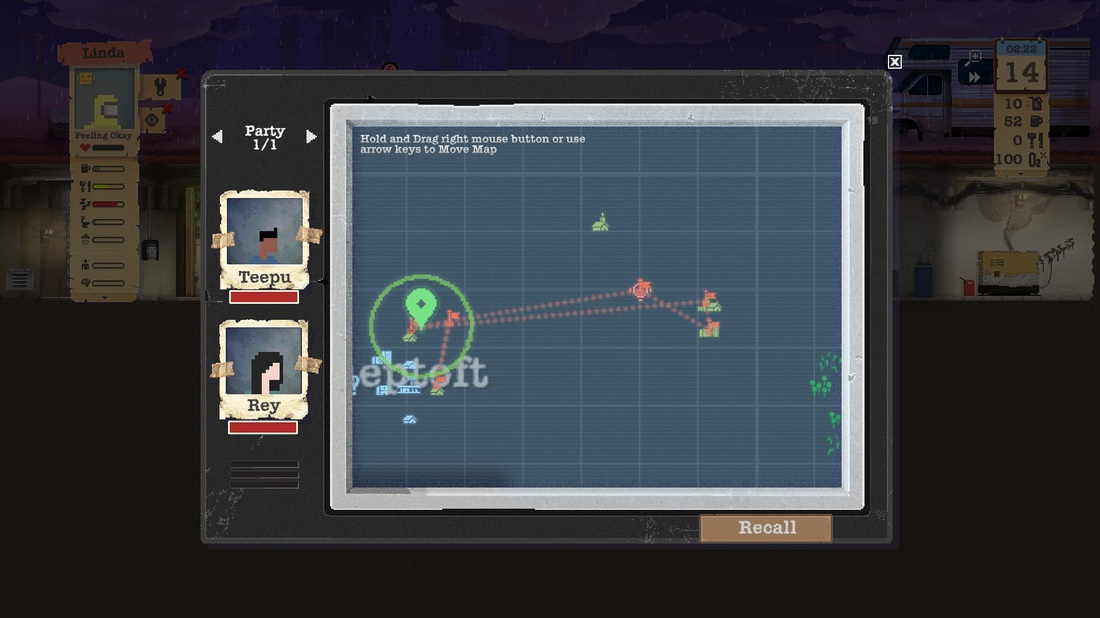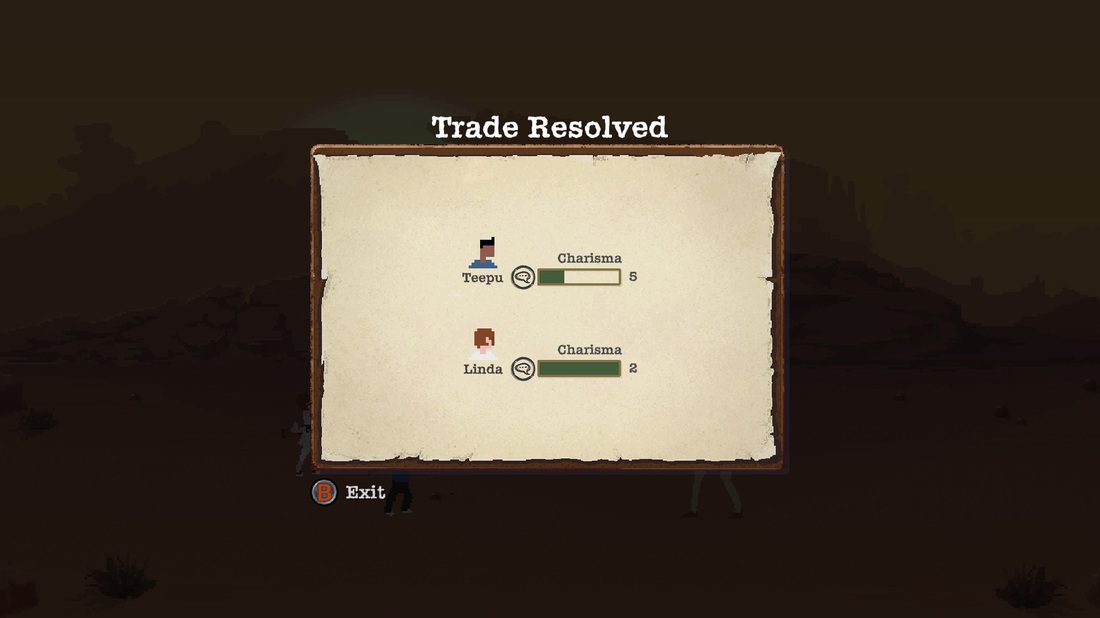|
Platforms: Windows and Mac (via Steam), Xbox One and PlayStation 4 Player(s): 1 If you’ve played mobile games like Fallout Shelter or Tiny Death Star, you might already have an idea for what to expect from Sheltered. Sheltered is a game that revolves around you helping your family of four survive in a post-apocalyptic world. You are in a simple shelter where you need to build, organize and manage various elements in order to assure survival. You start off by creating your family of four. You can choose what they look like (the options are admittedly a bit limited), give them names and also choose their personalities and traits. Their personalities and traits determine what kinds of skills, abilities and stats they will adopt, all of which will be displayed for you to see before you make your final decision. You are then thrown into your shelter with a very short and very basic tutorial. The game depends more on you discovering how to do things on your own, with the tutorial only giving you the basics of what you need to know to get started. With my increased complaining about the amount of hand-holding that takes place in video games these days, I found this to be particularly refreshing. Your shelter is split into rooms. Within each room, you can place objects such as beds, toilets or crates. This means that you are left with limited space. To make things interesting, you have resources which are in constant need of replenishment: water, oxygen, food and power. The main source of water is rain. You have a filter on the surface that filters the water into your base, where you will need retainers (which take up space) to store the water. Oxygen is provided via an oxygen filter on the surface, and doesn’t require much maintenance on your part. Food can be acquired via hunting, trapping, growing plants or scavenging. This, of course, requires a way of storage as well (pantry for rations and freezer for meat). Power is produced via a generator. The amount of power you use up per unit of time is proportional to the amount of items you have which draw power. For example, if you have a lot of freezers and lights in your shelter then you can expect to be using a lot of power per unit of time. The generator requires fuel (in the form of what looks like gasoline) to run. In order to help manage and run your shelter, you are provided with a work bench where you can build everything you need. The items you can build are split into 4 tiers, with increasingly efficient and useful items as you increase your building tier which requires upgrading your work bench. In fact, you can also upgrade your generator, oxygen filter and water filter multiple times to increase efficiency and durability. The majority of things in your shelter wear out with use, and will require you assign your shelter members to repair them. This is a simple process, but it requires that you pay attention to what’s going on in order to assure you don’t let anything break down. You can also upgrade your shelter doors, making them stronger in the event of an outside assault. Building things from your work bench requires various materials, which you acquire from either trading or going on expeditions to scavenge for parts. You can send up to two people at a time on an expedition (though you can set up multiple expeditions). You can equip various items to increase survivability or efficiency. A map is then pulled up, where you can plot your course via waypoints. Buildings and landmarks will be marked as you discover them. The distance you can venture is determined by how much water you have. Water is essentially your fuel. It’s important to note that this water is pulled straight from your water supply back at base, so don’t learn the hard way (like I did) that you could leave your people at home with no water. I really liked this mechanic because it was simple but helped to drive home the idea that your resources are finite. Your pair will then travel on their own, communicating with you via the radio. This is where things got particularly interesting to me. As they venture out, they can search buildings for loot, loot which will contain valuable building and upgrade materials as well as special items. There are three types of special items: RV parts, tools and blueprints. If you gather all the RV parts, you can use your RV to venture out, using fuel to offset the water use, travelling further than normal at a faster and safer rate and also providing significantly higher storage. The tools you find will be added to your workbench in order to increase repair and building efficiency. Finally, the blueprints will give you the ability to build special (generally overpowered) items such as beds that cure illnesses or ultimate weapons. While you’re out and about, you can also have random encounters with animals or people. If you run into an animal, you can choose to fight it (via a turn-based combat system) or run. The combat system is rather simplistic, revolving around dealing damage, defending, running or subduing the enemy (you can only subdue other people). That being said, it does offer enough engagement to keep the player interested. If you fight and win, you can harvest the meat and usually some leather as well. The more interesting bits are when you run into people. You can usually choose to trade, bully, fight or recruit these people. Sometimes you’ll run into marauders or belligerent people who’ll force you into combat, where you can try to flee or try to fight them. The trick is that if your team member dies, they’re dead. That’s it. So it’s important to think about survival over bravery when approaching these situations. Over time, other survivors will begin to create hostile factions who you’ll either have to take down or avoid altogether. Speaking of survival, we come to my second favorite thing about the game (the first being the expeditions). Your shelter members can be afflicted with various conditions, which require your attention. Some of them are basic, like hunger or lack of cleanliness. These basic needs you can automate, so you don’t need to constantly micromanage menial tasks. The real trick is in illness like radiation poisoning, food poisoning or bleeding. For these you require having medicines. Besides food poisoning, most illnesses will almost always result in death. This was especially fun when I ended up losing two of my original shelter members because I sent them out without gas masks and realized I didn’t have any anti-radiation medicine at base when they came back. When your team members die, this event also traumatize your other members. A shelter member death usually results in a few consequences, which allow you to deal with it as you see fit. Amidst all this, you can speed up time to help do things faster and easier. It’s interesting because you realize after an hour or two that the game is extremely repetitive and has a Sims-like menial quality to it. In a similar fashion, it also has an odd Sims-like addiction to it. Even though you’ll find that you’re mostly doing the same thing over and over, slowly working toward some simple goal (an oxygen filter upgrade, or a new bed, etc.), you’ll likely find yourself playing for a long time. I ended up surviving my single save file for a total of 269 in-game days and ended up playing for almost 20 hours before coming to write this review. Considering my general dislike of the play-styles of mobile games, I was surprised by how much I enjoyed this game (which follows a clear mobile play-style, minus the micro transactions). The game looks cute and excels at presenting itself in a simple 8/16-bit style which really gives it a grounded feeling. For anybody who enjoys strategy, survival or managing units, I highly recommend you give this game a chance. If they could make a believer out of me, they can likely make a believer out of you too. - Teepu Gameplay: AMAZING Graphics: AMAZING Sound: GREAT Value: AMAZING OVERALL: AMAZING Screenshot GalleryFULL DISCLOSURE: This game was provided to A-To-J Connections free-of-charge by the developers in order to write this review.
|
Search
Contributors◆ Angie
◆ Emily ◆ J.D. ◆ Janette ◆ JT ◆ Manuel ◆ Nestor ◆ Rose ◆ Sylvia ◆ Teepu ◆ Tiffany ◆ Winfield Archives
March 2025
|
© 2014-2025 A-to-J Connections. All Rights Reserved.






 RSS Feed
RSS Feed